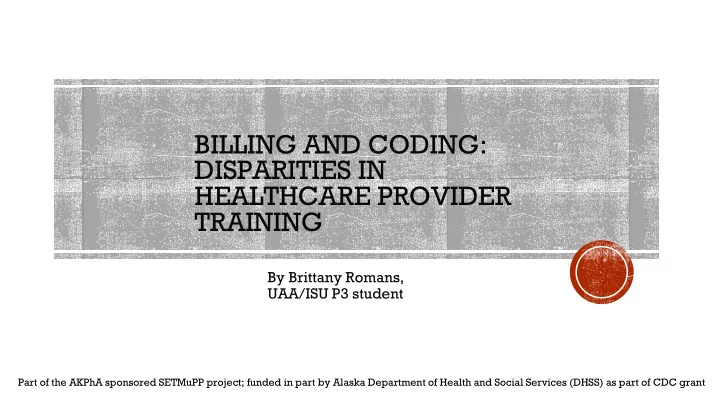

BILLING AND CODING: DISPARITIES IN HEALTHCARE PROVIDER TRAINING By Brittany Romans, UAA/ISU P3 student Part of the AKPhA sponsored SETMuPP project; funded in part by Alaska Department of Health and Social Services (DHSS) as part of CDC grant
OBJECTIVE ▪ Upon conclusion of this presentation, the participant should be able to recognize current billing training offerings within five discrete healthcare disciplines, as well as identify disparities between the disciplines of pharmacy, social work, dietetics, nursing, and medicine.
BACKGROUND & PURPOSE MEDICAL BILLING IS USED TO KNOWLEDGE ON MEDICAL MANY PROVIDERS DO NOT GOAL: COMPARE CURRENT TRANSLATE MEDICAL BILLING IS CRUCIAL TO RECEIVE FORMAL TRAINING BILLING AND CODING ENCOUNTERS INTO CLAIM RECEIVE PAYMENT FOR ON HOW TO DOCUMENT AND TRAINING OFFERINGS AND SUBMISSIONS PROVIDED HEALTHCARE BILL FOR SERVICES IDENTIFY TRAINING SERVICES DISPARITIES OF FIVE DISCRETE HEALTHCARE DISCIPLINES (E.G., PHARMACY, SOCIAL WORK, DIETETICS, NURSING, AND MEDICINE)
METHODS ▪ Literature Review: Performed using the PubMed database and Google Chrome Scholar ▪ MeSH terms: billing, coding, and curriculum ▪ Survey: ▪ Faculty of the top 100 U.S. colleges and universities offering degrees in social work, pharmacy, nursing, and medical studies were asked to complete a survey ▪ Dietetic school faculty identified via stateuniversity.com ▪ Contact information was obtained from the program website ▪ Two questions were asked of each school: ▪ Is billing/coding taught (in any capacity; single lecture vs. entire module) within the program curriculum? ▪ What resources are provided in the curriculum? Willingness to share resources Top 100 U.S. schools derived from lists provided by the U.S. World News Report
SURVEY: WHO WAS CONTACTED AND HOW? Who: 493 schools contacted How: 99 doctor of pharmacy schools Email (n=454, 92%) 94 social work schools offering MS degree Webpage (n=25, 5%) 96 dietetics schools offering MS or BS in nutrition Telephone (n=14, 3%) 104 nursing schools offering MS degree 100 medical schools offering a doctoral degree
RESULTS ▪ Literature Review: ▪ 18 peer-reviewed manuscripts - state the need for billing to be taught ▪ Survey: 26% of schools (129/493) responded to the survey, the majority being public institutions (72%) ▪ Pharmacy had mixed results (n=13, 23%) ▪ No social work schools taught billing (n=36, 0%) ▪ Dietetic schools were the most responsive and had the greatest number of billing programs (n=39, 92%) ▪ These were the only ones required to teach coding/billing, due to accreditation standards ▪ Nursing had mixed results (n=21, 52%) ▪ One medical school out of those that responded to the survey taught billing (n=20, 5%)
TOP 100 U.S. COLLEGES/UNIVERSITIES THAT RESPONDED TO SURVEY
DIETETIC SCHOOL CASE STUDY EXAMPLES
DIETETIC CODE EXAMPLES
LIMITATIONS Few published articles found • Hard to determine when billing training implemented Low survey response rate; especially in pharmacy
CONCLUSIONS ▪ Curriculums are based primarily on accreditation requirements ▪ Physicians utilize billing, however most medical schools don’t offer training ▪ Suggests training is outside curriculum or during residency ▪ Few nursing and pharmacy programs have established training programs on billing and documentation
ACKNOWLEDGEMENTS ▪ Sincere thanks to those college/university members who participated in the survey and provided curriculum information ▪ Sincere thanks to the other contributors to this project: ▪ Michael Biddle, Pharm.D. ▪ Elaine Nguyen, Pharm.D., MPH ▪ Andrew Hibbard, Pharm.D. ▪ Thomas Wadsworth, Pharm.D. ▪ Renee Robinson, Pharm.D., MPH, MSPharm
LEARNING ASSESSMENT – QUESTION 1 Out of the different professions contacted, which one had the highest rate of response? Pharmacy A. Social Work B. Dietetics C. Nursing D. Medical E.
LEARNING ASSESSMENT – QUESTION 1 Out of the different professions contacted, which one had the highest rate of response? Pharmacy A. Social Work B. Dietetics C. Nursing D. Medical E.
LEARNING ASSESSMENT – QUESTION 2 Out of the different professions contacted, which one had the lowest rate of response? Pharmacy A. Social Work B. Dietetics C. Nursing D. Medical E.
LEARNING ASSESSMENT – QUESTION 2 Out of the different professions contacted, which one had the lowest rate of response? Pharmacy A. Social Work B. Dietetics C. Nursing D. Medical E.
LEARNING ASSESSMENT – QUESTION 3 Why are dietetic schools required to teach billing/coding within their curriculum? It’s a popular topic amongst students A. To meet accreditation standards B. It’s not actually required C. For the fun of it D.
LEARNING ASSESSMENT – QUESTION 3 Why are dietetic schools required to teach billing/coding within their curriculum? It’s a popular topic amongst students A. To meet accreditation standards B. It’s not actually required C. For the fun of it D.
Recommend
More recommend